„Expanding the research horizons of the P-demotion domain: The crosslinguistic variation, diversity, and boundaries” at the International Congress of Linguistics
!!!! The deadline for abstract submission has been extended to 1 February 2024
Convenors: Katarzyna Janic, Krzysztof Stroński, Mohammad Tavakoli
Crosslinguistic studies show that many languages have several valency and voice alternations that share two defining characteristics: (i) they demote the P[1]-argument syntactically, (ii) but they do not affect the verb argument structure: agent remains agent, patient remains patient. Consequently, the so-called P-demotion constructions display a formal and semantic overlap and may include but are not limited to antipassive, conative, noun incorporation, and A-labile/A-ambitransitive alternations. The fact that there is a family of P-demotion constructions sharing important formal and semantic features mentioned above has never been explicitly stated in the literature. Nevertheless, some recognize more or less the scope of the P-demotion domain (Zúñiga & Kittilä 2019; Janic & Witzlack-Makarevich 2021b). More often than not P-demotion constructions are described as individual alternation types at the crosslinguistic level. This contrasts with a mirror image of impersonal alternations that also demote the core argument (A/S), yielding various types of impersonal clauses. Importantly, they have been recognized as a grammatical domain (Creissels 2008; various contributions in Malchukov & Siewierska 2011). Even if there is an apparent parallel between the P-demotion and impersonal alternations, the former has never been acknowledged as a grammatical domain in its own right. The workshop aims to fill this gap. It seeks to describe the P-demotion domain, where P-demotion results in various valency and alternation types that do not exist in neatly divided categories but gradually overlap crossing borders and classifications, to shape the contours of this hitherto scarcely studied domain.
Syntactic studies define the concept of demotion differently. In the seminal research on voice structure in Relational Grammar, demotion is defined as a theoretical primitive (Perlmutter 1980; Blake 1990). Many linguists, however, follow the Givónian tradition and define demotion in terms of the hierarchy of syntactic functions (e.g. Lehmann 2015: 1583). Regarding the syntactic P-demotion, it commonly refers to the antipassive alternation, implying that P loses the core argument coding properties. While some scholars view P-demotion as a gradient process, where P is suppressed or represented by an expression lower on the grammatical hierarchy: subject>object>non-core argument>non-argument (Polinsky 2017: 3), others consider P-demotion as coming in two guises, an oblique expression (1) or P suppression (2) (Zúñiga & Kittilä 2019: 4; Mithun 2021: 46; Janic 2021: 279). However, more often than not, comparative linguists limit the P-demotion mechanism to a change from core to an oblique (Næss 2007: 141; Malchukov 2015: 98; Haspelmath 2022: 19; Vigus 2018: 345).
a. Angathu nhanha wilha karlka-yi
1sg.erg 3sgf.acc woman-acc wait.for-prs
b. nganhi karlka-tharri-yi nhangkangu wilha-nhi
1sg.nom wait.for-antip-prs 3sgf.loc woman-loc
(a-b) ‘I wait for the woman.’
2. Ainu (Isolate; Bugaeva & Kobayashi 2022: 529)
a. nea kamuy a-ri kor
that bear 4.A-skin when
‘When I skinned that bear…’
b. i-ri-an wa or-o wa sini-an na.
antip-skin-4.S and place-poss and rest-4.S spf
‘I will skin and then have a rest.’
Hence, P-demotion is not seen as a unifying factor among antipassives in languages. However, what these studies have in common is that they consider P-demotion alternations, exemplified by the antipassive (1-2), operational because in most cases they imply a directional process, where one construction is basic and another is derived from it by a voice marker (e.g. like –tharri in 1 or i- in 2).
Even if it is commonly accepted that P-demotion is triggered by grammatical properties of a construction such as voice marking, most of the time this mechanism is limited to antipassive alternations alone. Consequently, other voice alternations meeting a definition of P-demotion are excluded from consideration. For instance, it is crosslinguistically not uncommon that P-incorporation that involves P-demotion is consistent with extra marking on the verb, like -i in (3). However, such alternations are treated outside of the voice domain as a distinct language phenomenon.
3. Soninke (Mande; Creissels 2021a: 310)
a. Yàxàrú-n dà kónpè-n céllà.
woman.pl-d cpl.tr room-d sweep
‘The women swept the room.’
b. Yàxàrû-n kónpó-séllè. (séllè < céllà + -i)
woman.pl-d room-sweep.detr
‘The women did room sweeping.’
On the other hand, if we limit P-demotion to the voice domain, various valency alternations like agent-preserving flexivalency[1] alternations (4-5) will be excluded from the P-demotion domain, even if they involve a P-demotion mechanism (cf. Haspelmath 2022: 16; Creissels 2023: 518). While in (4), demotion involves a change of P from core to an oblique, in (5), it refers to P-omission with an unspecified interpretation. Motivated by a discourse-pragmatic context, alternations like (4-5) are often verb-specific or subject to particular grammatical conditions in a language.
4. English
a. Alison shot the lion.
a. Alison shot at the lion.
5. Moloko (Afro-Asiatic; Friesen et al. 2017: 288, 282)
a. Mana a-sl-ay awak
Mana 3sg+pfv-slay-cl goat
‘Mana slaughtered a goat.’
b. Mana a-sl-ay
Mana 3sg+pfv-slay-cl
‘Mana slaughtered.’
The research questions include but are not limited to:
- To what extent P-demotion constructions are alike and differ in their form and function?
- How to capture the formal and functional overlap of P-demotion alternation without losing language-specific particularities and how to ensure their comparability?
- What are crosslinguistic generalisations based on P-demotion domain?
- Since P-demotion constructions result from the same P-demotion operation, we can speculate that they are diachronically related. Similar to other detransitivized constructions, they may develop from a regrammaticalization of some functionally related constructions, where the functional extension is influenced by functional resemblance of the syntactic construction (Givón 2001). Thus, what is the diachronic link between different functional varieties of P-demotion constructions?
The workshop is addressed to comparative and language experts interested in valency and voice alternations resulting from P-demotion whose research explores the boundaries and diversity of this phenomenon. It also invites theoretically-oriented scholars with a focus on methodology on how to compare P-demotion constructions and to catch their formal and functional overlap. Finally, it welcomes diachronic linguists interested in the development of P-demotion constructions.
References
Austin, Peter. 1981. A Grammar of Diyari, South Australia. Cambridge: Cambridge University Press.
Blake, Barry J. 1990. Relational Grammar. London: Routledge.
Bugaeva, Anna, and Miki Kobayashi. 2022. ‘Verbal Valency’. In Handbook of the Ainu Language, edited by Anna Bugaeva, 515–48. Boston: Mouton de Gruyter.
Creissels, Denis. 2008. ‘Impersonal and Related Constructions: A Typological Approach’. University of Tartu.
———. 2016. ‘Transitivity, Valency and Voice’. Porquerolles: European Summer School in Linguistic Typology.
———. 2021. ‘Antipassive Derivation in Soninke (West Mande)’. In Antipassive: Typology, Diachrony, and Related Constructions, edited by Katarzyna Janic and Alena Witzlack-Makarevich, 293–314. Amsterdam: John Benjamins.
———. 2023. Transitivity, Valency, and Voice. Oxford (UK): Oxford University Press.
Friesen, Dianne. 2017. A Grammar of Moloko. Berlin: Language Science Press.
Haspelmath, Martin. 2022. ‘Valency and Voice Constructions’.
Janic, Katarzyna. 2021. ‘Variation in the Verbal Marking of Antipassive Constructions’. In Antipassive: Typology, Diachrony, and Related Constructions, edited by Katarzyna Janic and Alena Witzlack-Makarevich, 249–91. Amsterdam: John Benjamins.
Janic, Katarzyna, and Alena Witzlack-Makarevich. 2021. ‘The Multifaceted Nature of Antipassive Constructions’. In Antipassive: Typology, Diachrony, and Related Constructions, edited by Katarzyna Janic and Alena Witzlack-Makarevich, 1–39. Amsterdam: John Benjamins.
Levin, Beth. 1993. English Verb Classes and Alternations: A Preliminary Investigation. Chicago: University of Chicago Press.
Malchukov, Andrej L. 2015. ‘Valency Classes and Alternations: Parameters of Variation’. In Valency Classes in the World’s Languages, edited by Andrej L. Malchukov and Bernard Comrie, 1:73–130. Comparative Handbooks of Linguistics, 1.1-1.2. Berlin: De Gruyter Mouton.
Malchukov, Andrej L., and Anna Siewierska, eds. 2011. Impersonal Constructions: A Cross-Linguistic Perspective. Amsterdam: John Benjamins.
Mithun, Marianne. 2021. ‘Antipassive Propensities and Alignment’. In Antipassive: Typology, Diachrony, and Related Constructions, edited by Katarzyna Janic and Alena Witzlack-Makarevich, 43–64. Amsterdam: John Benjamins.
Næss, Åshild. 2007. Prototypical Transitivity. Amsterdam: John Benjamins.
Vigus, Meagan. 2018. ‘Antipassive Constructions: Correlations of Form and Function across Languages’. Linguistic Typology 22 (3): 339–84.
Zúñiga, Fernando, and Seppo Kittilä. 2019. Grammatical Voice. Cambridge: Cambridge University Press.
[1] Valency alternations with no verb coding (Haspelmath 2022).
[1]A and P are generalized roles, they refer to the core arguments coded like agents and patients of core transitive verbs respectively, whilst S defines the core argument of intransitive constructions with coding properties corresponding to that of the unique argument of major monovalent verbal predicates (Creissels 2016: 28).
Abstract submission
Abstracts should clearly state the research question(s), approach, method, data, and (expected) results. They should not display the names of the presenters, nor their affiliations or addresses, or any other information that could reveal their authorship. They should contain the title, five keywords, and a text between 300 and 400 words (including examples, excluding references).
The deadline for all abstracts is 8 January 2024. Each abstract will be reviewed anonymously by two reviewers. Notification of acceptance will be 15 April 2024. Abstracts for the workshop are submitted via Easychair. Submission link for ICL abstracts: https://easychair.org/conferences/?conf=icl2024poznan
Workshop „Expanding the research horizons of the P-demotion domain: The crosslinguistic variation, diversity, and boundaries”, September 13, 2024
On September 13, 2024, the convenors, Katarzyna Janic, Krzysztof Stroński, and Mohammad Tavakoli, held the workshop organized by the International Congress of Linguistics (ICL). The workshop participants took us on a worldwide journey, exploring the P-demotion phenomenon across various language groups, including Oceanic, Indo-Aryan, and broader Indo-European languages. We also delved into language-specific accounts of P-demotion, examining South Ryukyuan from Japan, and Chatino from North America. Additionally, two presentations provided insights into P-demotion from typological and computational perspectives. The workshop started with Katarzyna Janic’s introduction, who presented the concept of P-demotion, the workshop’s research motivation, and its organisation. The workshop integrated 7 various topics encompassed by the term ‘P-demotion’ from multiple research perspectives. These include synchrony and diachrony, descriptive linguistics, computational linguistics, and crosslinguistic typology. During the lunch break, participants gathered at the restaurant to enjoy the company and time together. The workshop concluded with a lively and engaging discussion, offering the prospect of publishing the volume by De Gruyter as part of the Trends in Linguistics


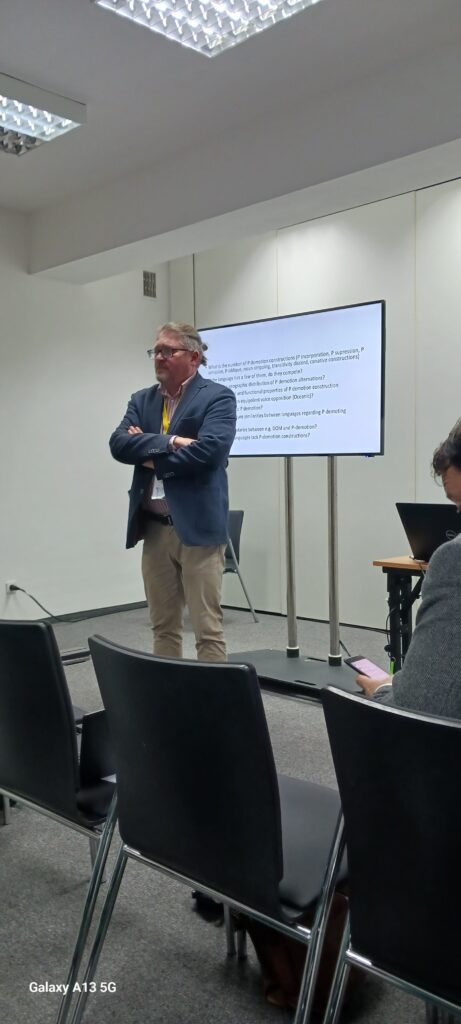
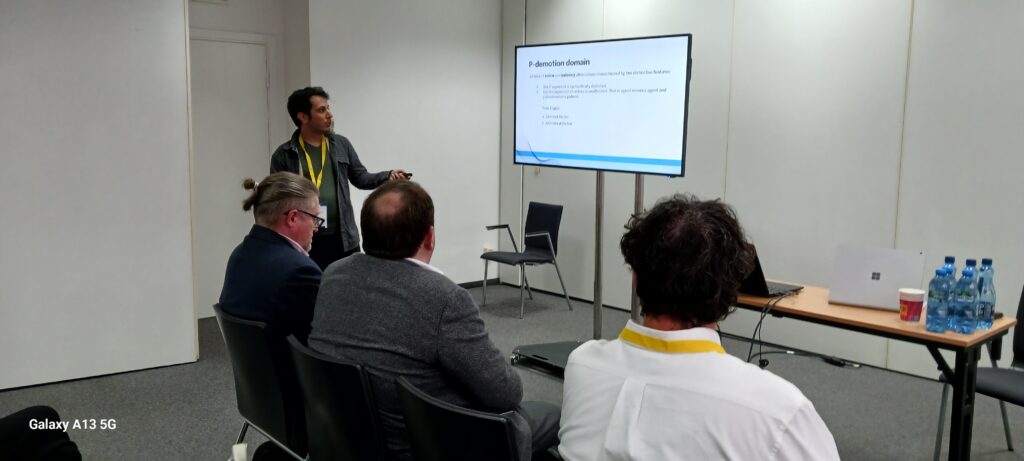
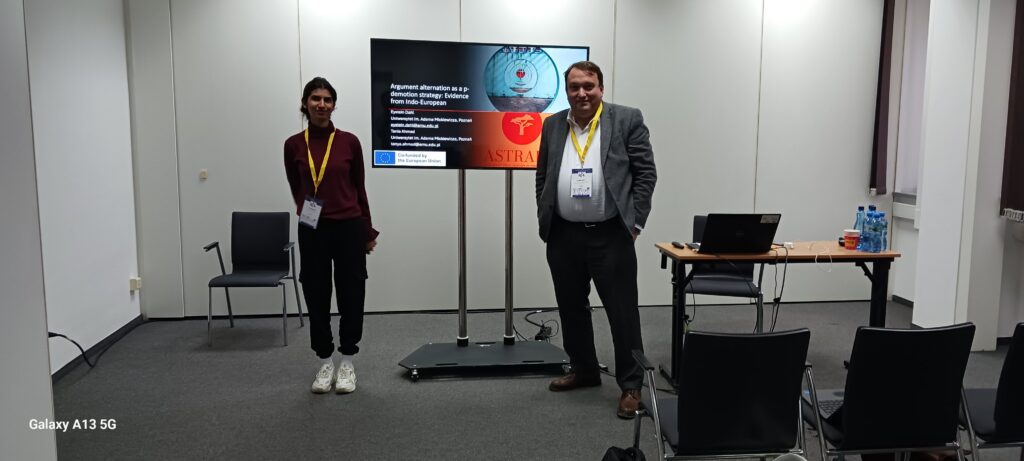
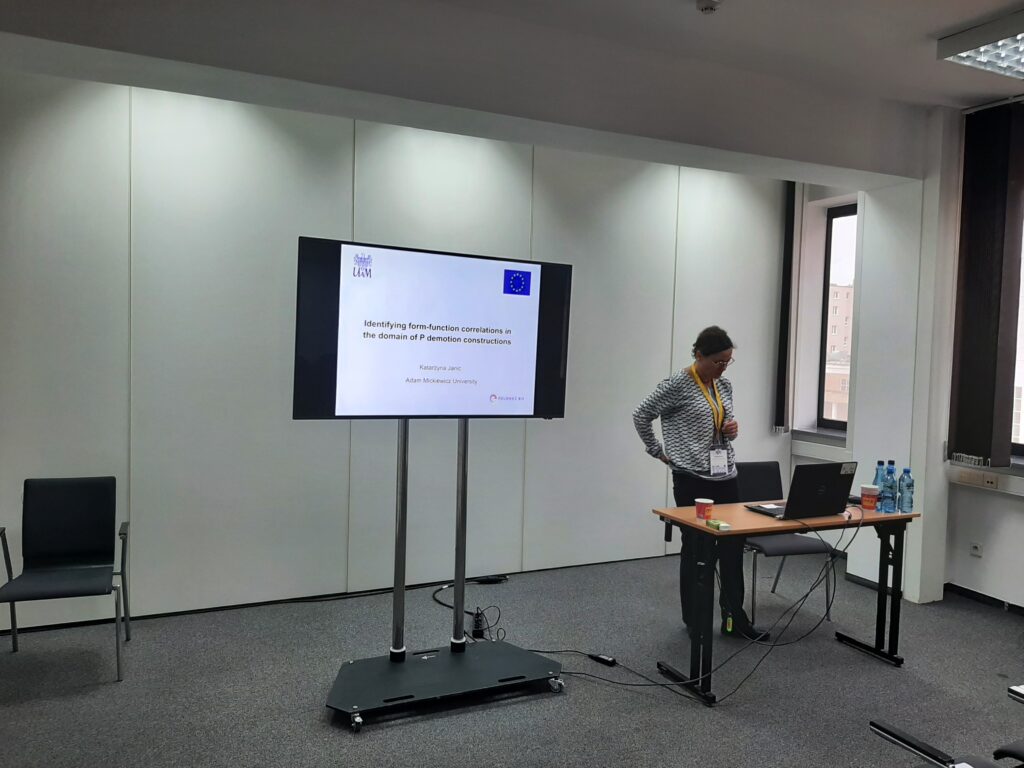
Other talks included:
Katarzyna Janic: Introduction to the workshop „Expanding the horizons of the P-demotion domain: The crosslinguistic variation, diversity, and boundaries„
Valentina Alfarano and Lidia Federica Mazzitelli: „Towards a typology of patient-backgrounding phenomena in Oceanic languages”
Krzysztof Stronski: Discussion
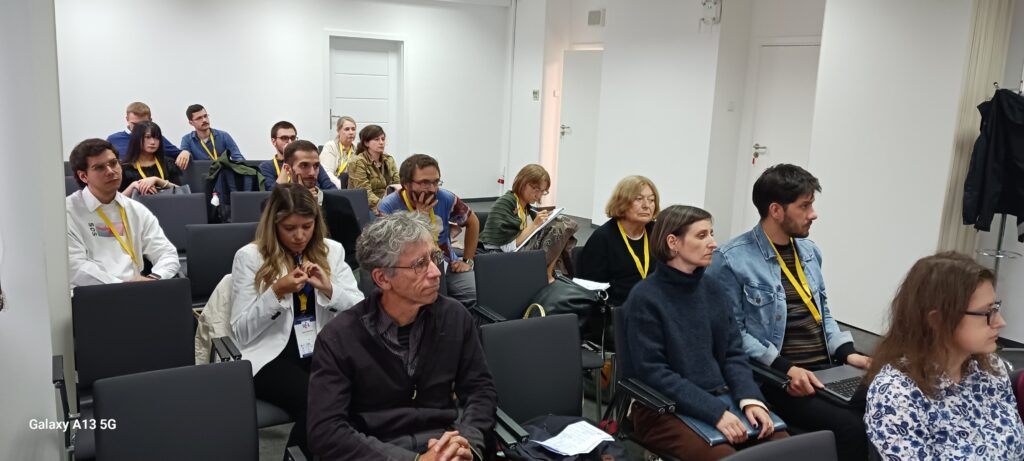
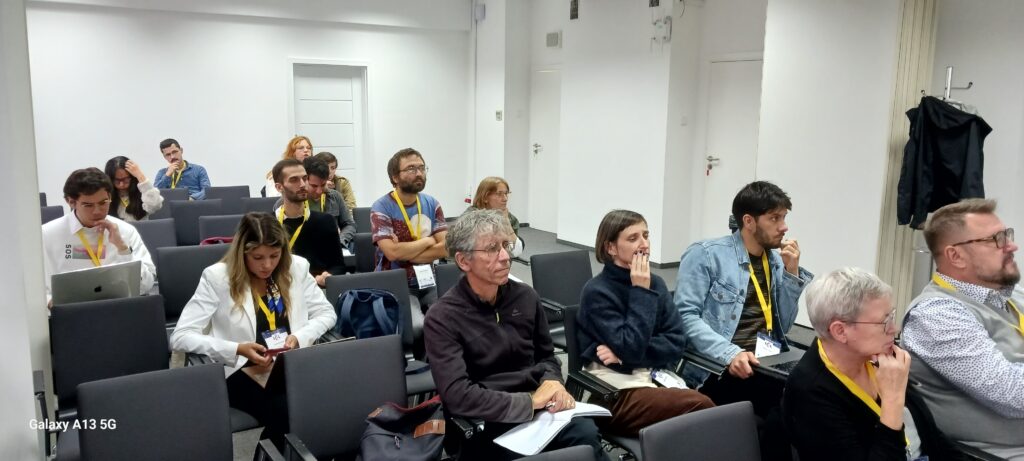

The workshop participants and contributors gathered at the restaurant table, including Mohammad Tavakoli (on the left), followed by Tanya Ahmad, Krzysztof Stroński, Katarzyna Janic, Eric Cambell, Aleksandra Jarosz, and Valentina Alfarano.
